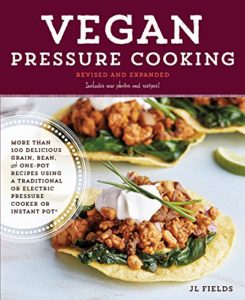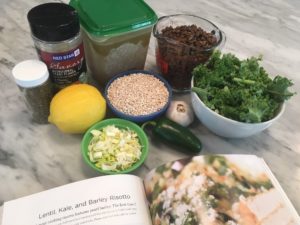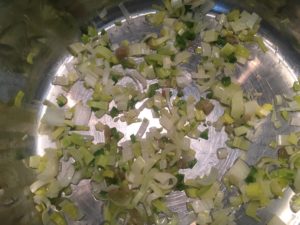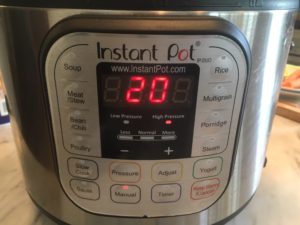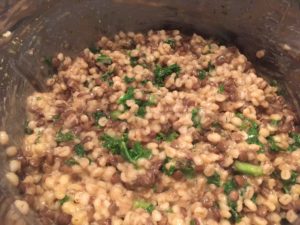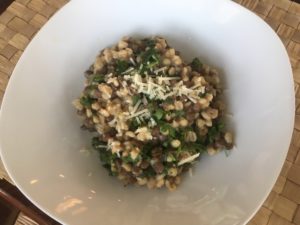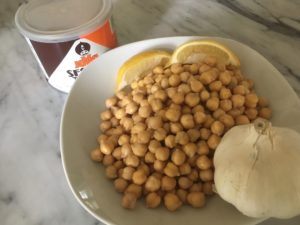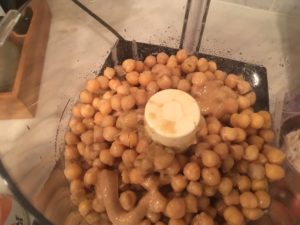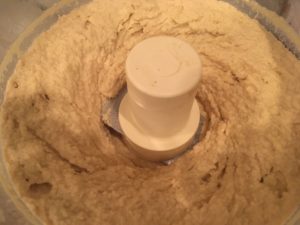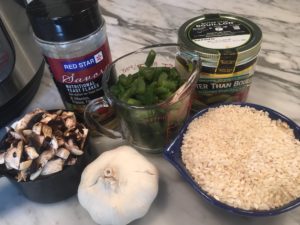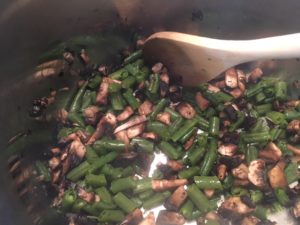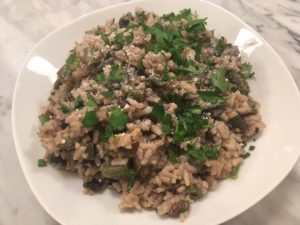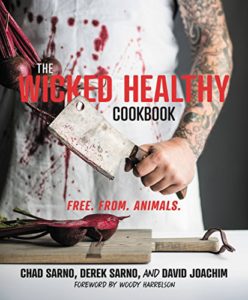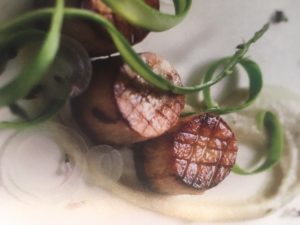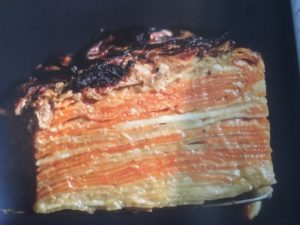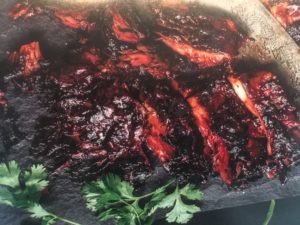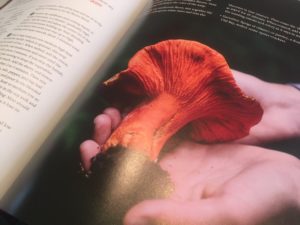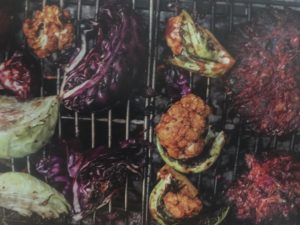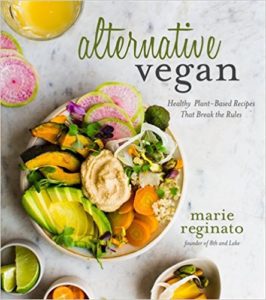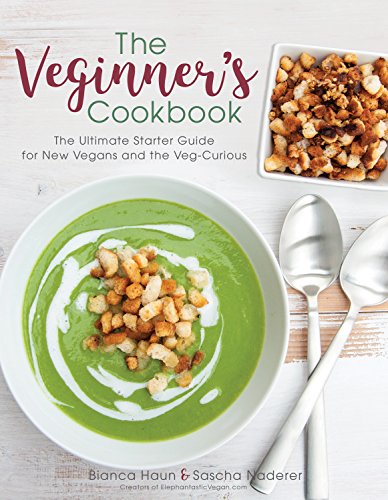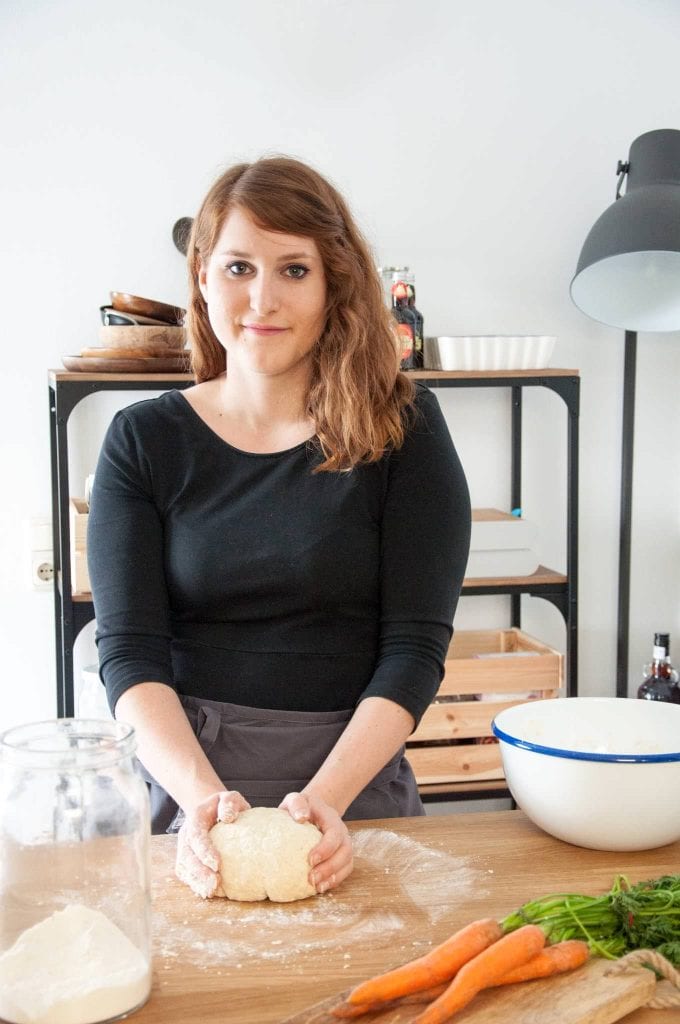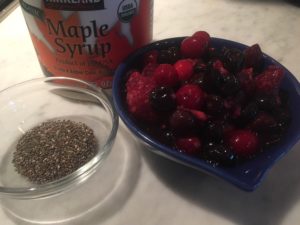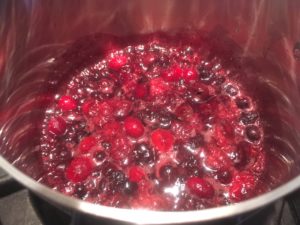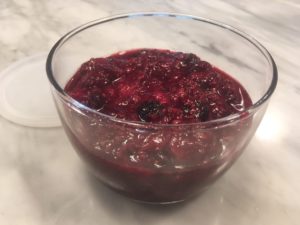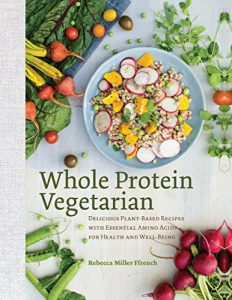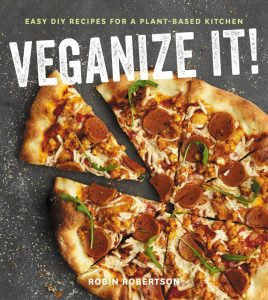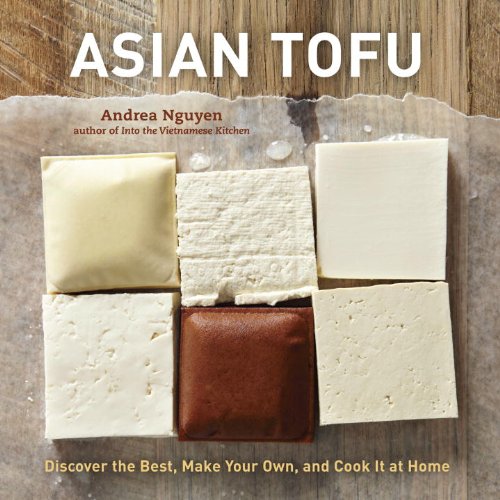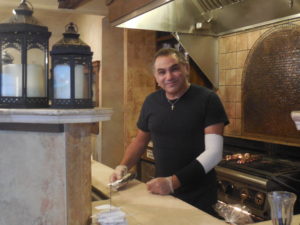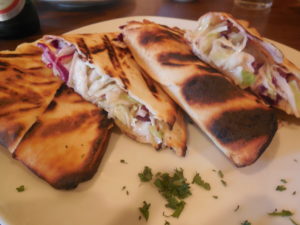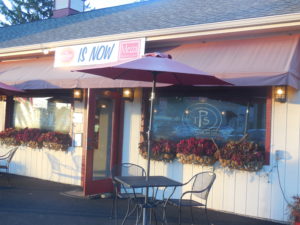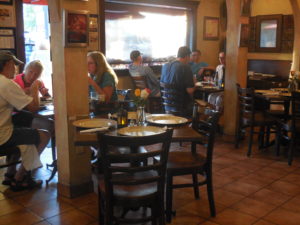Tag Archives: vegan
What We Eat
“Eat food, not too much, mostly plants.” –Michael Pollan
After over a decade on a whole-foods, plant-based diet – with long-term forays into oil-free as well – we started to take stock and make some changes. Neither of us had lost any weight, despite a reasonable exercise regime – and didn’t feel as energetic as we’d like. We were also concerned about brain health, sufficient quality Omega-3s, and took a lot of cues from the lifestyles of the “blue regions.”
To be clear, we don’t believe that there is any one diet that works for everyone. But there are some basic underlying givens – organic and non-GMO to start. The Environmental Working Group’s Dirty Dozen (or 18) and Clean 15 list (ewg.org) is the place we start to decide where to spend our organic food dollars. To augment what we get weekly from our CSA.
To change from such a long-time vegan lifestyle was not easy, but we both agreed it was time, We started by just adding a little fish to our diet to ensure quality omega-3s. But not just any fish or seafood – we made a list based on, again, the Environmental Working Group’s (ewg.org) high omega 3s and low mercury list combined with the Monterey Aquarium’s sustainability list. Those lists have since been combined so there is now just one easy source (ewg.org). With a couple minor exceptions, these are all wild-caught seafood from sustainable populations. We also have a secondary list that is not particularly beneficial, but not particularly harmful – either to us or to the environment. Clams, shrimp, even the occasional lobster lands on that treat list – but still, all wild caught. Nothing farmed, except for Rainbow Trout or from the evolving totally land-locked aquaculture community.
Our friends were delighted! Entertaining us was now so much easier. To accommodate our diet, they happily centered meals on wild-caught Alaskan salmon and everyone at the table was content.
After a year or so, we decided to look further. While we had lost weight on five-day all-organic juice and smoothie fasts, we inevitably gained it all back. We both wanted to lose about 15 pounds – permanently – to be healthier, look better, and regain large swaths of our closets. So we needed to find a diet that was satisfying for the long term and would also help us meet our weight goals.
We explored many options to find an approach that was grounded in evidence with a science that made sense. We decided to try Mark Hyman’s 21-day “Eat Fat, Get Thin” diet. It was pretty much life-changing for both of us. We found it very easy to follow, never felt deprived and started to lose weight – slowly and consistently. After our experiences on an oil-free plant-based diet, and having been steeped for decades in “low-fat” and “a calorie is a calorie” propaganda, it was really hard to add all those healthy fats. But we did, and, for us, it worked.
Hyman adopted the newly minted “PEGAN” to describe his maintenance plan – the best of paleo and vegan – and we have embraced a lot of it permanently. We still don’t eat meat or fowl. But we have dramatically limited our grains and beans, have added lots of healthy fats, continue to eat small portions of wild-caught fish and seafood, and are both at – or very near – our goal weights. Our plates are about 2/3-3/4 vegetables, 1/8-1/6 protein (fish, tofu, etc.), with nuts, seeds, organic extra-virgin olive oil, and three specific kinds of cheese as condiments. We cook only with avocado and organic coconut oils, (and very occasionally with ghee and organic sesame oil). The Organic EVOO is always added after cooking.
The grains: Quinoa (actually a seed), black rice, wild rice, organic brown rice (only occasionally and cooked in a big pot of water like pasta), Italian Arborio rice, amaranth, and millet. We experiment with a little bread – mostly organic mixed seeds and grains (Dave’s Killer) and whole-grain gluten-free (Udi’s). And we limit pasta to GF quinoa, red-lentil, and Miracle/Shirataki Noodles (made with Konjac). Plus we also spiralize a lot of veggies, which we actually find very satisfying.
Dairy: We continue to use only organic plant-based milk (almond and coconut plus canned full fat coconut milk) and, for the most part, plain organic coconut and almond yogurts. But we have also recently toyed with grass-fed organic full-fat cows milk Greek yogurt (Stonyfield’s Totally Grass-Fed Organic plain Greek yogurt) – to see how we feel. As for cheese – this is a very personal list: Only authentic Italian Parmigiano Reggiano, authentic Greek Sheep’s Milk Feta and French goat cheese (Chevre). That’s it. We trust these European sources far more than American ones and can find them easily even in the big box stores (they just cost a little more).
At the same time, we are giving up most vegan cheeses because they seem to be so full of undesirable ingredients. But we are withholding judgment because of the new wave of clean plant-based dairy from Miyoko, Kite Hill and other local sources. But as of now, they are very pricey. We have stopped eating most of the ersatz vegan substitutes like sour cream, some of the yogurts, and butter-substitutes because they have very long ingredient lists filled with things that we prefer not to consume. To date, we have not been successful in making our own plant-based yogurt. But we will continue to try.
Eggs? Yes! Pastured, organic, free-range. Three times as much as supermarket CAFO eggs, but there is a real difference that you can see and taste. And the consensus, at least this year, is that the right eggs are healthful. So an over-easy egg on a mess of steamed power greens (baby chard, spinach & kale with a pinch of turmeric) drizzled with EVOO is the standard breakfast these days.
Sweeteners are confined to organic stevia, organic maple syrup, organic dates and organic strawberry jam – and an occasional drizzle of hyper-local honey from our neighbors’ hives. We also stock organic peanut butter, sun butter, and almond butter, along with an array of olives, capers, pickles, artichoke hearts and lots of other unctuously lovely foods. Umami comes from an assortment of mustards and five kinds of miso. We’ll leave a full panty list for another post, but suffice it to say there is very little processed food of any kind.
Beverages are mostly organic green tea, lemon filtered water, iced tea, an occasional glass of wine (and for my husband coffee and beer).
Bottom line, we rarely, if ever, feel deprived, and find it remarkably easy to dine out or be a dinner guest (we just get a little flexible and stay on course at home). We think that choosing what and how one eats should be a continually evolving process – informed by reliable, reproducible, evidence-based studies. That it is important to not get stuck with titles, or too invested in one’s food choices as a large a part of one’s identity – because then you feel less free to change. Try something that resonates and if it works, great. If it doesn’t, step back and try something else. (Oh, and BTW, my IBS which has informed my life for at least seven years has mostly disappeared……).
Vegan Pressure Cooking – New and Expanded
By JL Fields
Fair Winds Press 2018 $22.99
With all the discussions about the benefits of pressure cookers for preparing beans and grains, I was excited to read and cook from Vegan Pressure Cooking – especially since the revised, expanded edition includes special instructions for Instant Pots!
There are some helpful, basic tips on pressure cooking in general, adjustments for various types, and plethora of full-page, color photos of the finished dishes – for roughly half of all recipes. There’s a serious emphasis on beans and grains – which is where pressure cookers really shine. Sometimes, for green and other non-starchy vegetables, the set-up, pressure-raising and releasing takes longer than simply plopping a pot on the stove (or using the microwave).
I am an Instant Pot fan, but its size encourages tucking it away in the pantry. Out of sight; out of mind. I was counting on this book re-energizing that appliance. And it certainly did. As a result, the IP is still on the counter after a positive week of trying some of JL Fields’ recipes. I skipped the green beans as not logical for an IP and headed toward the beans and grains.
The first recipe was “Lentil, Kale and Barley Risotto.” Two cups of cooked lentils were defrosting in the fridge and kale and jalapenos were in the hydrator – so it was a perfect choice. The recipe worked exactly as described and was delicious – but three of us ate most of it (and the servings listed are 6-8). Next time, I would be less judicious with the jalapeno (the heat was barely detectable) and add the baked tofu as the author suggested (or perhaps a sliced vegan sausage or two) which might stretch it to the suggested servings. The photo was a very tight close-up so it was hard to tell if my effort looked like the author’s.
“Chickpea Hummus” was next. Homemade hummus is a staple in our house – but more often than not from cans. A quick, delicious version from dried beans would be welcome. The chickpeas were soaked for 24 hours and then sat, drained, in the fridge for a day. I subbed the white part of leeks for the onion (that’s what I had) and reduced the garlic by half (since aggressive garlic is not loved by all in this house). There were two problems – the 15 minutes under high pressure with natural release was not nearly long enough in an IP (I let it gurgle on saute for another 20 minutes). And the flavor was bland – particularly surprising because onion is not traditional. Perhaps adding cumin, or maybe more lemon. Next time, I will try high pressure for 20-25 minutes (after all, preserving the shape of the chickpea is not relevant for hummus), use a real onion and up the garlic a little to the suggested quantity (and add cumin).
The next choice was “Lemon Green Bean Risotto.” Except for the color of the dish, this was a success. Perhaps the stock was too dark giving the final product an unappealing brownish tinge. Other than that, it was creamy and hands-free – pretty amazing for risotto. I will definitely try this again with a lighter colored stock.
The Wicked Healthy Cookbook – Free. From. Animals. (Preliminary Review)
By Chad Sarno, Derek Sarno, and David Joachim
Grand Central Life & Style, Hachette Book Group, New York, NY 2018 $30
I love this book!!! From the minute it arrived, I was lost. Just skimming the essays, lists, Pro Tips and stunning recipes and images took me into the wee hours. Putting it down was not an option. Granted, my guilty pleasure is reading cookbooks. But this is a very special tome. Just when it felt like plant-based cuisine had reached its limits, with book after book adding a few new spins but churning the same ground, Wicked Healthy has seriously upped the ante. It’s fun, exciting, innovative, energetic, – the enthusiasm for the possibilities of plant-based gastronomy leaps off the pages. Dust off that mandoline!
To be clear this is not a book for every veg-forward cook. It is not an intro to the philosophy or a beginners’ guide. Some of the recipes are challenging, time-consuming and utilize esoteric ingredients that may require the resources of Whole Foods, Amazon, H-Mart, Thrive, a sophisticated farmers market and a few small mail-order houses – and even then you may have to be satisfied with recommended subs. It’s also, not surprisingly, a bit cheffy – many ingredients lists include other recipes so, unless you have a staff, there is sometimes serious time required. But it will be well-spent, satisfying time – even the process of discovering new or less-available ingredients will be well-spent, satisfying time. Bottom line, if all you do is just read The Wicked Healthy Cookbook, you can’t help but appreciate the expanded possibilities of plant-based cookery.
This is just my first review. I am going to cook my way through a good chunk of the book and post the results as I go. Starting with their bold new take on mushrooms: King Oysters, Maitakes, and Lobsters. What fun!! I can’t wait.
(One question – olive oil instead of avocado oil for high heat cooking?)
Alternative Vegan – Healthy Plant-Based Recipes that Break the Rules
By Marie Reginato
Page Street Publishing, Salem, MA. 2017
I love the sentiments and attitude in this book! After more than a decade on a relatively strict “whole food, plant-based” diet, we started a little rethinking – prompted by a series of research reports that stacked one question atop another. I worried about the quantity and quality of our omega-3 and protein intake. We were also feeling a little bored and needed to amp up the deliciousness of our food. We agreed it was time to break just a few of the rules: we added some pastured organic eggs, a little sustainable, low-mercury, high-omega 3 seafood and two specific European cheeses to our diet*.
A couple months later “Alternative Vegan” landed in my lap – encouraging the breaking of pretty much the same rules!
Aside from the affirmation provided by the author (saying just what we wanted to hear), this is a solid effort that adds variety and originality to the cookbook shelf – clear recipes that work, full-page, bleed images of every recipe that inspire, and a thoughtful approach to food in general. Wherever there is rule-breaking, the author provides a vegan alternative.
The recipes tend to depart from the expected which is, for those of us with dozens of plant-based cookbooks, a welcome relief. On the other hand, these are not “throw dinner together in a few minutes” recipes. Not even the 30-minute ones. The ingredient lists tend to be lengthy but not esoteric – if you’ve been eating plant-based for a while, you’ll find most of them on the pantry shelf. Cupboard Curry is just that and Minty-Pistachio Falafels with Tzatziki gives these old stand-bys a fresh flavor profile. Also welcome are two takes on sliced “pre-cooked polenta rolls” that get a yummy dish on the table quickly.
As a lover of dinner leftovers for breakfast, I found the Morning Glory Bowl even better; it’s a made-from-scratch, well-seasoned, Swiss chard, spinach, fennel, avocado and dill breakfast (or maybe brunch) dish. The recipes bounce between creative riffs on traditional favorites and some really unique ideas – and that originality extends to the unexpected chapter titles. There’s Breakfast and Dessert (Dark Chocolate with Lime Zest & Pumpkin Seeds!!) – but standard headings stop there. The chapter on Bento Boxes and Buddha Bowls adds some new perspectives as does the Ex-Rated chapter on pizza and pasta. But the main events are mostly in Eating on the Vedge.
I do take issue with some of the “alternative” choices – IMO, eggs should be “pastured” as well as organic and the seafood choices should align with the Environmental Working Group’s detailed assessment of sustainable, low-mercury and high omega-3s. But those are my personal choices and all of the seafood recipes will work just fine with other species …..
*The specifics of our alternative choices are covered in the post – “Shhh! We’ve Decided to Break a Few Rules!”
The Veginner’s Cookbook – The Ultimate Starter Guide for New Vegans and the Veg-Curious
by Bianca Haun and Sascha Naderer
Skyhorse Publishing, January 16. 2018
My first reaction to this beautifully photographed, inviting tome was “What a great name! How come no one else thought it?” And it is actually a perfect name. This is a nicely done intro to vegan food. If you have been cooking and eating a plant-based diet for a while, or are deep into the various nutritional perspectives, you might not find a lot new here. But if you are thinking about dipping a toe in the vegan waters, it’s a very solid beginning.
All of the culinary bases are covered; the authors provide a current overview of the plant-based landscape – and have even included a couple of “finds” like kala namak (Himalayan black salt) for an eggy taste. The full-page color photos of the finished dish are excellent – and really required for beginners. The goal is clearly to ease the first-timer into the concept of meat and dairy-free cooking and eating without adding the additional challenges of limiting some oils or using only whole grains and whole-foods. It is a reasonable approach.
The authors, Bianca & Sascha, are an Austrian couple who are passionate about their relatively recent adoption of veganism and share their experiences on their blog ElephantasticVegan.com as well as in this new book. They also provide a little hard-won guidance for newbies who are navigating the sometimes treacherous social waters of “well a little won’t hurt, will it?” or “where do you get your protein?” Sascha calls it the “Landmine Situations.”
We also appreciate the Bianca’s Kitchen Hacks that are scattered throughout the book. These are little hints for the newbie and some additional thoughts for the more experienced.
Be aware: The nutritional philosophy that underlies their book is straight-ahead vegan (as opposed to whole-foods, plant-based): veggies, grains, nuts, seeds, oils (especially canola oil* – which is concernful). You won’t find a lot of whole grains, gluten-free or sugar/sweetener-free recipes. Their main concern with white sugar, for instance, is that it is vegan (and not made with bone char) rather than that is may be very bad for your health. Baking begins with white all-purpose flour with a nod to some options (that said Healthy Breakfast Muffins are made with oat flour). That is not a criticism as much as a buyer-aware alert. (Also for recipes that contain miso, be sure not to let it boil or you will kill off the probiotics.)
We love the Small-Batch Strawberry Chia Jam – quick and easy and delicious (so convenient when you discover you’ve just run out – see images below). The last time I used frozen organic mixed berries with a smidge more maple syrup. And the curries are inventive and easy, as well. The Hummus Four Ways are strikingly beautiful and the Shake and Bake Sweet Potato Fries inspiring (a keeper in this house)! Love the banana-based “Nice Creams”, too. I am surprised by the canned lentils in the Thyme Lentil Soup (unless you are on a Low FOD-MAP diet). Dried lentils would have taken just another 15 or so minutes.
Bottom line: This would make a great gift for someone who has expressed interest in experimenting with a plant-based diet. The recipes will be successful and delicious – and visually appealing. It will get most people over the hump and show them that this is a viable diet. And, even if they don’t go the whole way, they will have found a lot of recipes that will stay in their rotation no matter what.
(*Canola Oil – perhaps the canola oil available in Austria is less tainted than what we can get in the US. I substituted Avocado oil or Coconut oil for the canola oil in the recipes that I tried. Also subbed tomato sauce or tomato puree for tomato passata.)
My Take on “Veganism”
Up until a dozen years ago, we’d been innocently and happily eating a whole-foods, sugar-free, “healthy diet” for about three decades; it included low-fat dairy, white meat chicken and fish. But then, my husband “pushed through” on a New York Marathon feeder race, collapsed and was unceremoniously hauled off to a local hospital. That was when we learned that he had plaque on his arteries! I took this as a personal affront to my hard-won nutritional knowledge and culinary expertise.
After listening to my angst-ridden breast-beating, a friend handed me the “Eating” DVD (3rd Revision) – it was a revelation. The interviewees weren’t McDonald addicts or slab-of-beef on the plate types; these were people who’d been eating just like us. And their health profiles were just like ours. Once they embraced a whole-foods, plant-based lifestyle – aka veganism – their health improved: plaque disappeared from arteries, insulin requirements nose-dived, weight slid off…… We were smitten and embraced this new life-style with vigor and enthusiasm.
Today we’re still eating a primarily plant-based diet. We know that we’re healthier with it, that animals suffer less because of it and that the planet is better off (we could trade our Prius for a Humvee and our carbon footprint would still be impressive). But we’ve lost the religiosity. We prefer the term WFPB over Vegan because it is not so loaded. We still use the terms vegan or strict vegetarian in restaurants because plant-based does not compute with servers. But to the rest of the world, we call it a whole-foods, plant-based diet.
Over time, we’ve gotten easier with it. When we travel or dine out – especially at friends’ homes – we expand our options to include wild-caught salmon, mussels, oysters, brook trout and a couple other low-mercury, high omega-three, sustainable species (kudos to the Environmental Working Groups for simplifying this). Blue crab and lobster also make the few-times-a-year list because there are Crab Feast and Lobster Bake traditions on both sides of our families. On occasion, we also eat free-range “humanely raised” eggs. It makes life easier for everyone and, frankly, we welcome these occasional additional options. That said, when we are home, we eat a pretty strict WFPB diet – we like it; it’s easy and it allows us to “regroup” especially after long bouts of travel. When we entertain, it’s almost always a WFPB meal as well; we work hard at delivering luxuriously delicious meals that usually end with a dark chocolate dessert – and, hopefully, make the lack of animal products unnoticeable and irrelevant.
We don’t proselytize and only discuss our food choices when asked; we hope that this low-key approach might make the plant-based concept less off-putting and more appealing. It seems to us that the fewer animal products one eats and the more organic produce one consumes, the better off everyone is (for organic, we shop with the EWG’s Dirty Dozen [actually 20] and Clean Fifteen lists). As Columbia Professor Emeritus Joan Dye Gussow would say to the “Earth Friends” fourth graders: “it’s better for both worlds you inhabit – your body and your planet.”
We are fans of Meatless Mondays, Mark Bittman’s “VB6” (Vegan Before 6 pm), and any other variation that encourages people to dip a toe into this lifestyle. This is not a religion; it is a choice that is a win-win-win for you, for the animals, for the planet. Our philosophy is: just do what works for you; no one is taking notes.
Whole Protein Vegetarian – Delicious Plant-Based Recipes with Essential Amino Acids for Heath & Well-Being
By Rebecca Miller Ffrench. The Countryman Press 2016 $27.95 (Amazon $18.50/ Kindle $14)
Ms. Ffrench approaches recipes and daily menus from the very particular perspective of amino acids – in other words protein. There is a mantra in the plant-based world that it’s impossible not to get enough protein. That we actually consume too much protein and the invariable question from the canivores “how do you get your protein?” is mock-worthy.
But the author demonstrates that that might not be as true as we had assumed I was surprised when taking a hard look at the protein counts of some of the pulses and vegetables that we normally consume. If adequate protein is a concern, then this might be a useful reference.
It’s a handsome, hard covered book with bleed and full-page photos of about half the recipes. The recipes themselves are not particularly adventuresome or noteworthy – assuming you are steeped in current plant-based culinary arts. If you are not, then this is an excellent primer. I prepared a couple and they were fine family-dinner fare – but not guest material.
VEGANIZE IT! Easy DIY Recipes for a Plant-Based Kitchen
BY Robin Robertson – Houghton Mifflin Harcourt March 7, 2017. $25. Amazon $14.92/ Kindle $12.99
Another really good book from one of the top vegan cookbook authors. Robin Robertson’s books are classics and I have most of them. So I had high expectations for this one. It’s a beautifully designed book with a stiff fold-in cover for marking your place and lots of full-page photos and chapter intros that sometimes bleed across a double-page spread.
The chapters are similar to those of an omnivore cook book – with a twist. Plant-Based Meats, Vegan Charcuterie, Instead of Seafood, Dairy-Free and Egg-Free, Too…. all very enticing.
Since 2010, I’ve been turning to Steen & Newman’s “The Complete Guide to Vegan Food Substitutions: Veganize It! Foolproof Methods for Transforming Any Dish into A Delicious New Vegan Favorite.” And collecting recipes from chef-written cookbooks, blogs and the www. There have been so many advances in plant-based cooking in the past six years that I thought Roberstson might, essentially, be providing an updated, cutting edge version of “The Complete Guide…”. And in some ways she has. But I was hoping for some break-through ideas instead of riffs on existing chef or blogger-developed veggie cuisine. Or at least a compilation of those best of the best ideas. But I misunderstood the intention – which might have had something to do with the similarity of the titles…..
Instead, the book provides “clean” vegan recipes for lots of basics like sour cream cream cheese, cheesy sauces, ricotta, hollandaise, feta, butter!, gravy plus many, many more. Beyond basics are burgers, pulled pork, fish ‘n chips, sausages, meatballs, sea scallops, five bacon recipes, and more. Many of these products are available in the supermarket freezer or refrigerator case but made with a laundry list of additives and other unpronounceable ingredients. So this is why I add the word “clean.” Ms. Robertson first chapter includes home-made versions of pantry items (many of which are not vegan in their store-bought versions). Each chapter also includes more involved recipes that use a few of the basics made from the included recipes or, if time is short, from store-bought versions.
I started my review by preparing a couple of the recipes. First was Creamy Ranch Dressing that starts with 1 cup of mayo – it had good flavor but the mayonnaise was too prominent so I cut it with a little almond milk that also made it more pourable. The second one was Cheddary Sauce which is pictured below (these are my photos, not from the book). This was a tasty cream sauce and it worked well over a steamed veggie and quinoa bowl, but it didn’t taste anything like cheese, especially cheddar, which the name implied. I made it in a Vita Mix so just letting it blend a little longer heated it up – once the cashews had been soaked, it was quick and easy despite a lengthy list of ingredients. I will make it again – perhaps amping up the seasonings and playing with the liquor choices. Next up are the five bacon recipes and the pulled pork.
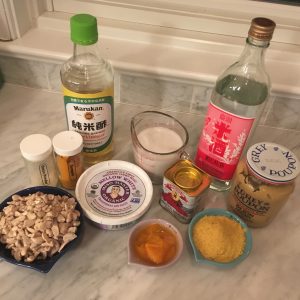
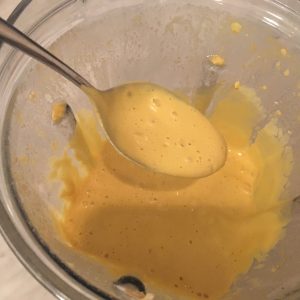
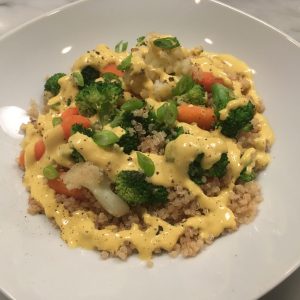
A couple nitpiks: Recipes labeled with cheesy names have to taste cheesy – nooch just doesn’t taste cheesy to me. And there isn’t any nutritional info – I’d like to know the calorie count and the percentage from fat – is it a 30-cal tablespoon or a 125 cal one? Also while the cashew craze has been well addressed, alternatives would be appreciated (since cashews are high-FODMAP) and a little more on aquafaba would also be helpful and suggestions for those among us who choose oil-free.
Bottom line – this book is a keeper. There are enough interesting concepts in here to encourage experimentation. It is not haute cuisine, but it is reliable, tasty, clean vegan. And that’s worth a lot.
Asian Tofu
by Andre Nguyen. Ten Speed Press 2012, Large format, hard cover $30 ($23.56 or $12.99 Kindle)
The only book that I owned on making tofu was the “Book of Tofu” by William Shurtleff and Akiko Aoyagi circa 1979. It’s a very yellowed, dense paperback ($2.95 then*) filled with tons of information. But somehow it always intimidated so when I picked up Nguyen’s “Asian Tofu” with lots of big, beautiful photos, graphics and white space (albeit at ten times the price ), I was encouraged to try this again.
Not surprisingly the basic recipe that Nguyen uses is almost the same as Shurtleff’s – she just makes it sound easier. It’s soybeans, water and coagulant with a proper mold and accoutrements – that’s pretty much it. Nguyen begins with a highly detailed Homemade Tofu Tutorial: an immersion in the various types starting with soy milk, then on to silken tofu, tofu pudding, block tofu, seasoned pressed tofu, tea-smoked pressed tofu, white fermented tofu, fresh tofu skin and soy-simmered fried tofu. The rest of the book is devoted to how to use each kind of tofu once you successfully mastered it. Again, the photos are the name of the game here. Seeing the process and knowing what you’re going for makes all the difference. She has encouraged me to try this to see if the result is as good as or even better than the lovely artisanal product produced by The Bridge Company in Middletown, CT. (I was privileged to spend several hours there watching the process – seeing how very minimally processed this product can be.)
Nguyen continues to teach the reader/cook through chapters on Snacks and starters, Main Dishes, Salads, Mock Meats, Buns, Dumplings, Crepes, and Sweets. . She ends with a chapter on Basics that covers stocks, and sauces. Be aware this is not a totally plant-based book. There are many recipes using seafood and meat. But, as in her earlier book, plant-based substitutions are relatively easy and it is a host of basic concepts that she is teaching.
*BTW: The original “Book of Tofu” is still available for $7.23 on Amazon (used $0.1 and up) and a new edition, “Book of Tofu – Protein Source of the Future… Now!,” a larger paperback with photos, updated information and newly designed covers, was published in 2012 ($17.95, available from $8 up). That might be well worth purchasing. Together these two books will tell you all you want, need or wish to know about tofu.
